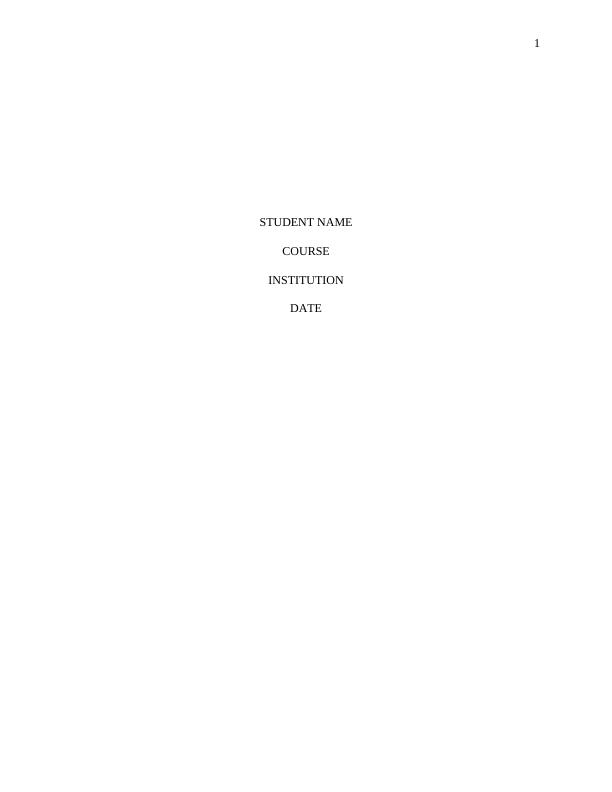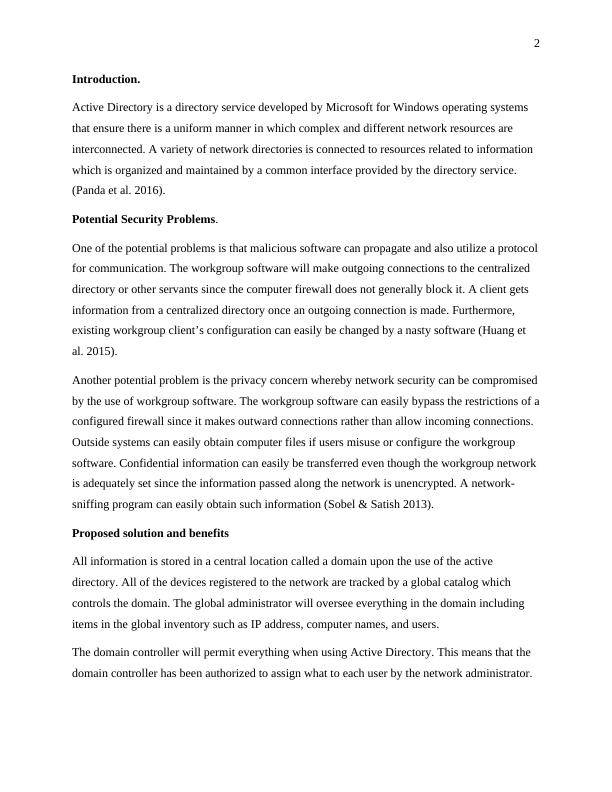Potential Security Problems with Active Directory and Proposed Solutions
Added on 2023-06-04
4 Pages541 Words318 Views
1
STUDENT NAME
COURSE
INSTITUTION
DATE
STUDENT NAME
COURSE
INSTITUTION
DATE

2
Introduction.
Active Directory is a directory service developed by Microsoft for Windows operating systems
that ensure there is a uniform manner in which complex and different network resources are
interconnected. A variety of network directories is connected to resources related to information
which is organized and maintained by a common interface provided by the directory service.
(Panda et al. 2016).
Potential Security Problems.
One of the potential problems is that malicious software can propagate and also utilize a protocol
for communication. The workgroup software will make outgoing connections to the centralized
directory or other servants since the computer firewall does not generally block it. A client gets
information from a centralized directory once an outgoing connection is made. Furthermore,
existing workgroup client’s configuration can easily be changed by a nasty software (Huang et
al. 2015).
Another potential problem is the privacy concern whereby network security can be compromised
by the use of workgroup software. The workgroup software can easily bypass the restrictions of a
configured firewall since it makes outward connections rather than allow incoming connections.
Outside systems can easily obtain computer files if users misuse or configure the workgroup
software. Confidential information can easily be transferred even though the workgroup network
is adequately set since the information passed along the network is unencrypted. A network-
sniffing program can easily obtain such information (Sobel & Satish 2013).
Proposed solution and benefits
All information is stored in a central location called a domain upon the use of the active
directory. All of the devices registered to the network are tracked by a global catalog which
controls the domain. The global administrator will oversee everything in the domain including
items in the global inventory such as IP address, computer names, and users.
The domain controller will permit everything when using Active Directory. This means that the
domain controller has been authorized to assign what to each user by the network administrator.
Introduction.
Active Directory is a directory service developed by Microsoft for Windows operating systems
that ensure there is a uniform manner in which complex and different network resources are
interconnected. A variety of network directories is connected to resources related to information
which is organized and maintained by a common interface provided by the directory service.
(Panda et al. 2016).
Potential Security Problems.
One of the potential problems is that malicious software can propagate and also utilize a protocol
for communication. The workgroup software will make outgoing connections to the centralized
directory or other servants since the computer firewall does not generally block it. A client gets
information from a centralized directory once an outgoing connection is made. Furthermore,
existing workgroup client’s configuration can easily be changed by a nasty software (Huang et
al. 2015).
Another potential problem is the privacy concern whereby network security can be compromised
by the use of workgroup software. The workgroup software can easily bypass the restrictions of a
configured firewall since it makes outward connections rather than allow incoming connections.
Outside systems can easily obtain computer files if users misuse or configure the workgroup
software. Confidential information can easily be transferred even though the workgroup network
is adequately set since the information passed along the network is unencrypted. A network-
sniffing program can easily obtain such information (Sobel & Satish 2013).
Proposed solution and benefits
All information is stored in a central location called a domain upon the use of the active
directory. All of the devices registered to the network are tracked by a global catalog which
controls the domain. The global administrator will oversee everything in the domain including
items in the global inventory such as IP address, computer names, and users.
The domain controller will permit everything when using Active Directory. This means that the
domain controller has been authorized to assign what to each user by the network administrator.

End of preview
Want to access all the pages? Upload your documents or become a member.
